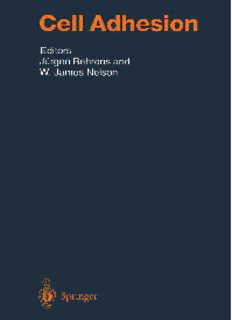
Cell adhesion PDF
Preview Cell adhesion
Handbook of Experimental Pharmacology Volume 165 Editor-in-Chief K. Starke, Freiburg i.Br. Editorial Board G.V.R. Born, London M. Eichelbaum, Stuttgart D. Ganten, Berlin F. Hofmann, M(cid:2)nchen B. Kobilka, Stanford, CA W. Rosenthal, Berlin G. Rubanyi, Richmond, CA D Berlin Heidelberg NewYork HongKong London Milan Paris Tokyo Cell Adhesion Contributors G. Berx, L. Borradori, T. Brabletz, P.F. Bradfield, H.-J. Choi, S. Getsios, L.M. Godsel, K.J. Green, A.K. Horst, A.C. Huen, W. Ikeda, B.A. Imhof, K. Irie, R.L. Juliano, J. Koster, Y. Miyamoto, U. M(cid:2)ller, W.J. Nelson, B. Nieswandt, S. Offermanns, T.D. Perez, P. Reddig, T. Sakisaka, H. Semb, K. Shimizu, A. Sonnenberg, E.T. Stoeckli, K. Strumane, Y. Takai, F. Van Roy, C. Wagener, W.I. Weis Editors J(cid:2)rgen Behrens and W. James Nelson B D Professor Dr.J(cid:2)rgenBehrens Nikolaus-Fiebiger-Zentrum f(cid:2)rMolekulareMedizin Universit(cid:3)tErlangen-N(cid:2)rnberg Gl(cid:2)ckstrasse6 91054Erlangen,Germany e-mail:[email protected] W.JamesNelson,Ph.D. DepartmentofMolecular&CellularPhysiology BeckmanCenterB121 StanfordUniversitySchoolofMedicine Stanford,CA94305-5345 USA e-mail:[email protected] With59Figuresand10Tables ISSN0171-2004 ISBN3-540-20941-7Springer-VerlagBerlinHeidelbergNewYork LibraryofCongressCataloging-in-PublicationData Celladhesion/contributors,GBerx...[etal.];editors,J(cid:2)rgenBehrens andW.JamesNelson. p.m.–(Handbookofexperimentalpharmacology;v.165) Includesbibliographicalreferencesandindex. ISBN3-540-20941-7(alk.paper) 1. Celladhesionmolecules. 2. Celladhesion.I.Berx, G. II.Behrens,J(cid:2)rgen,Dr.III. Nelson,W. J. (W.James)IV.Series. QP905.H3vol.165 [QP552.C42] 615'.1s–dc22 [571.6] 2004042951 Thisworkissubjecttocopyright.Allrightsarereserved,whetherthewholeorpartofthematerial isconcerned,specificallytherightsoftranslation,reprinting,re-useofillustrations,recitation,broad- casting, reproduction on microfilm or in any other way, and storage in data banks. Duplication of this publication or parts thereof is permitted only under the provisions of the German Copyright Law of September 9, 1965, in its current version, and permission for usemust always be obtained fromSpringer-Verlag.ViolationsareliabletoProsecutionundertheGermanCopyrightLaw. Springer-VerlagisapartofSpringerScience+BusinessMedia springeronline.com (cid:3)Springer-VerlagBerlinHeidelberg2004 PrintedinGermany Theuseofgeneraldescriptivenames,registerednames,etc.inthispublicationdoesnotimply,even intheabsenceofaspecificstatement,thatsuchnamesareexemptfromtherelevantprotectivelaws andregulationsandfreeforgeneraluse. Product liability: The publishers cannot guarantee the accuracy of any information about dosage andapplicationcontainedinthisbook.Ineveryindividualcasetheusermustchecksuchinformation byconsultingtherelevantliterature. Editor:Dr.R.Lange DeskEditor:S.Dathe Coverdesign:design&productionGmbH,Heidelberg Typesetting:St(cid:2)rtzAG,97080W(cid:2)rzburg Printedonacid-freepaper 27/3150hs–5 4 3 2 1 0 Preface Aswithotherareasofbiologicalresearch,theprogressthathasbeenmadeover thepast25yearsinthefieldofcelladhesionisimpressive.Inthelate1970s,the searchforspecificcellsurfacereceptorsforadhesionprocesseswasinitiatedus- ing mainly biochemical and immunological approaches. Since then, the intro- duction of novel methods of cellular and molecular biology and powerful tech- niquesformanipulatinggeneexpressionintransgenicandknock-outmicehave greatly advanced the field. Not only do we now know the precise molecular structureofmanyofthe celladhesionreceptorsthatwerepostulatedto exist in the early days, but we have a clear picture of their function, and evidence of theirinvolvementinsignaltransduction.Wehavealsofoundcluestotheroleof cell adhesion in normal embryonal development and adult physiology, and we haveevidencethatdisturbanceincelladhesioncancausedisease. Inthisvolume,ourgoalwastoprovideanoverviewofthemaintopicsofcur- rent cell adhesionresearch, includingstructural analyses ofcell adhesionmole- cules and studies oftheir functionalrole invitroand invivo.Wehave focussed mainly onthe four major families of cell-adhesion receptors, i.e. the cadherins, the integrins, the Ig superfamily and the selectin-based adhesion system. The chapters by Perez and Nelson and Choi and Weis describe the structural basis of cadherin function, focussing on the extracellular domain of cadherins and thecytoplasmictailinteractionswithcatenins,respectively.Sembreviewsthein vivo functions of cadherins with an emphasis on normal embryonal develop- ment, and Strumaneet al. describethe alterationsofcadherins in cancerdevel- opment and metastasis. A chapter by Brabletz is devoted to the in vivo role of the catenins, highlighting the signal transduction function of b-catenin in the Wnt pathway. The molecular composition and function of desmosomes are the topicofthechapterbyGodselandcolleagues,introducingdesmosomalcadherins and their link to the cytoskeleton. Integrins are dealt with in three reviews: an overview ofsignal transductiontriggeredby integrin-mediated adhesion is giv- en by Miyamoto et al., the in vivo function of integrins as revealed by mouse models is described by M(cid:2)ller, and the role of integrins and associated compo- nents in the hemidesmosome is reviewed by Koster and co-authors. In the sec- tiononIgsuperfamilyadhesionreceptors,HorstandWagenerandIrieandcol- leagues describe the structure and cellular function of two major subfamilies, VI Preface the CEACAMs and nectins, respectively. Stoeckli has contributed a chapter on theroleoftheIgsuperfamily inbrain developmentwherethe diversityofthese adhesionreceptorsisparticularly prominent.Two chaptersdealwiththephysi- ological function of adhesion receptors in the adult organism. The chapter by BradfieldandImhoffocussesonleukocyte–endotheliuminteractionsandintro- duces the selectins and their interplay with Ig receptors and integrins, and the chapter byNieswandt and Offermanns deals withplatelet aggregationin hemo- stasis and thrombosis, where detailed molecular analysis has already reached thelevelofpharmacologicalapplication. Whatwillbethefuturetrendsincelladhesionresearchandthepotentialap- plicationof this knowledgeforhuman disease, and inparticular for pharmaco- logical applications (which is the underlying interest of this handbook series)? It can be expected that our knowledge of the in vivo functions of cell adhesion receptors and mechanisms will continueto increase as more mouse models are generated. Naturally, this will have an impact on our understanding of disease processesthatarerelatedtodefectivecelladhesion.Paradigmsforthis,toname only two, are the implications of E-cadherin being a metastasis suppressor in human cancer, or the detailed knowledge ofblood clotting being based on spe- cific cell adhesion processes. Moreover, the perception of cell adhesion mole- cules as signalling receptorsandtheirdetailed structuralanalysiswill hopefully set the stage for new pharmacological approaches. Thus, cell adhesion research willstayasexcitingasithasbeen. I hope that this book will serve as a helpful guide for students and for re- searchers from other disciplines, and also be a valuable source of reference for ourcolleaguesinthefield. J(cid:2)rgenBehrens,Erlangen List of Contributors (Addressesstatedatthebeginningofrespectivechapters) Berx,G. 69 Nelson,W.J. 3 Borradori,L. 243 Nieswandt,B. 437 Brabletz,T. 105 Bradfield,P.F. 405 Offermanns,S. 437 Choi,H.-J. 23 Perez,T.D. 3 Getsios,S. 137 Reddig,P. 197 Godsel,L.M. 137 Green,K.J. 137 Sakisaka,T. 343 Semb,H. 53 Horst,A.K. 283 Shimizu,K. 343 Huen,A.C. 137 Sonnenberg,A. 243 Stoeckli,E.T. 373 Ikeda,W. 343 Strumane,K. 69 Imhof,B.A. 405 Irie,K. 343 Takai,Y. 343 Juliano,R.L. 197 VanRoy,F. 69 Koster,J. 243 Wagener,C. 283 Weis,W.I. 23 Miyamoto,Y. 197 M(cid:2)ller,U. 217 List of Contents PartI.Cadherins CadherinAdhesion:MechanismsandMolecularInteractions ............ 3 T.D.Perez,W.J.Nelson StructuralAspectsofAdherensJunctionsandDesmosomes ............. 23 H.-J.Choi,W.I.Weis CadherinsinDevelopment ........................................ 53 H.Semb CadherinsinCancer............................................. 69 K.Strumane,G.Berx,F.VanRoy InVivoFunctionsofCatenins...................................... 105 T.Brabletz TheMolecularCompositionandFunctionofDesmosomes.............. 137 L.M.Godsel,S.Getsios,A.C.Huen,K.J.Green PartII.IntegrinsandExtracellularMatrix RegulationofSignalTransductionbyIntegrins........................ 197 Y.Miyamoto,P.Reddig,R.L.Juliano IntegrinsandExtracellularMatrixinAnimalModels................... 217 U.M(cid:2)ller Hemidesmosomes:MolecularOrganizationandTheirImportance forCellAdhesionandDisease...................................... 243 J.Koster,L.Borradori,A.Sonnenberg PartIII.ImmunoglobulinSuperfamily CEA-RelatedCAMs .............................................. 283 A.K.Horst,C.Wagener X ListofContents RolesofNectinsinCellAdhesion,SignalingandPolarization............ 343 K.Irie,K.Shimizu,T.Sakisaka,W.Ikeda,Y.Takai IgSuperfamilyCellAdhesionMoleculesintheBrain ................... 373 E.T.Stoeckli PartIV.PhysiologyandPathologyofCellAdhesion AdhesionMechanismsofEndothelialCells ........................... 405 P.F.Bradfield,B.A.Imhof PharmacologyofPlateletAdhesionandAggregation ................... 437 B.Nieswandt,S.Offermanns SubjectIndex................................................... 473
